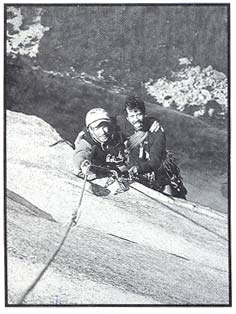

Last September the nation's attention was captured by Mark Wellman, a paraplegic, and his able-bodied climbing partner Mike Corbett-they successfully climbed the 2,200 foot vertical face of Yosemite's Half Dome. Because the climbers were plagued by bad weather, the rock's grainy texture, and a 20-foot fall by Corbett, the ascent of the difficult Tis-Sa-Ack route took 13 days, rather than the anticipated eight
Wellman had to traverse eight miles of wilderness (from 4000 feet to 8000 feet) to the base of Half Dome before starting the climb. The day-long trip was completed in two parts: a three-hour trip by mule followed by an arduous one-mile, five-hour journey piggy-back across a steep boulder field. The piggy-back phase of the journey was accomplished on the shoulders of Ted Farmer, a member of the support crew.
Although the climb was primarily a personal challenge, Wellman's effort also helped to raise $50,000 for the Yosemite Association. The funds were designated for accessibility projects such as the restoration of current trails, rather than the construction of new traiIs, new roads, or a tramway.
As a preservationist, Wellman believes that "wilderness should be left in a pristine condition. Yosemite and other National Parks need to devise ways for the disabled to use wilderness areas that will not harm the environment or change the scenery within wilderness areas." At one time, a cable car to Yosemite's Glacier Point was seriously considered but never built (Alfred Runte, Yosemite: The Embattled Wilderness). Wellman contends that, "If Half Dome had a tramway there would have been no reason to climb it. It would have redefined the area as something other than wilderness and would have taken away from the experience."
On the 75th anniversary of the National Park System (NPS), there is a great deal of soul searching among National Park. officials about their mission. The NPS is under siege to replace wilderness areas with paved roads, parking lots, hotels and other facilities. Preservationists, on the other hand, seek to scale back development and commercial activities in the nation's parks (NY Times, 9/23/90 & 5/27/91).
Wellman maintains that "bringing in a backloader and cutting a trail into the environment to make an accessible traiI is not the answer. The NPS should develop programs which rely on the use of stock (e.g., horses and mules) and encourage the development of wheelchairs which could negotiate natural trails." Wellman agrees with the position of behavioral scientist, Joseph Sax. Sax asserts that, "To make wilderness areas more accessible by installing roads would put the visitor in the wilderness without exposing him to it, and would also intrude upon others' opportunities to experience challenging wild areas" (Mountains Without Handrails: Reflections on the National Parks).
With the passage of the Wilderness Act of 1964, the United States set aside lands to protect the natural qualities of those areas from encroachment and indiscriminate development (The Wilderness Act Handbook). David Park, Chief of Special Programs and Populations for the NPS, notes that "there are 42 such designated wilderness areas within the nation's 357 national parks."
In an initial attempt to balance the issue of disability access with that of preservation, the NPS (1984) issued a policy statement which stressed that accessibility for the disabled be "consistent with the nature of the area and program and consistent with the obligation to conserve park resources and preserve the quality of the park experience for everyone." (Special Directive 83-3, NPS).
The National Council on Disability convened a public forum on the disability access issue in August of 1990 in Jackson Hole, Wyoming. The forum, entitled "Access to the Wilderness", is the first step in a process to study and report to the U.S. Congress on the effect that wilderness designations and wilderness land management practices have on the ability of individuals with disabilities to use and enjoy the National Wilderness Preservation System (Americans with Disability Act of 1990).
At first glance, disability access and wilderness preservation appear irreconcilable. How can the disabled experience the wilderness without adversely altering the environment? To most, this question only raises opposing viewpoints with one side ultimately succumbing to the other. Perhaps the question should be phrased what potential wilderness access solutions could be created that would balance the needs and rights of the disabled with those of the wilderness preservationists?